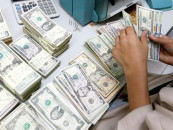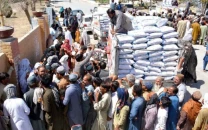Correcting West's narrative on Pakistan
Talk of being in 'deep crisis' due to Chinese loans is far from reality

Pakistan's economy is poised to enter a sustainable growth phase after achieving recent stability. This is evident as renowned global credit rating agencies, including Fitch and Moody's, upgraded Islamabad's credit rating in July and August. These upgrades acknowledge that Pakistan has navigated out of economic and financial dangers, averting a major risk of default on foreign debt repayments between 2023 and 2024.
However, a New York Times opinion piece last month (August 2024) claimed, "Pakistan is mired in a deep economic crisis that it can't climb out of, partly because of the need to pay billions of dollars in loans to China for infrastructure and other projects."
This claim starkly contradicts the facts. Pakistan is no longer in a deep economic crisis but is instead on the verge of transitioning from stability to growth. Inflation has returned to single digits, standing at 9.6% in August 2024 after three years. Foreign exchange reserves have hit a 26-month high of $9.43 billion, more than triple the amount recorded in February 2023. The rupee-dollar exchange rate has remained stable at Rs278-279/$ for over five months, with the current account deficit narrowing to breakeven. Workers' remittances have surged, and export earnings are on the rise. The State Bank of Pakistan (SBP) is expected to make its third consecutive significant interest rate cut of 1-1.5 percentage points next week (on September 12) to further support economic activity.
As for the second part of the opinion piece's claimthat Pakistan is trapped by billions in loans to China under the Belt and Road Initiative's (BRI) flagship China-Pakistan Economic Corridor (CPEC) projectit's essential to recall that China was the first nation to provide crucial financing during Pakistan's peak economic and financial crisis between January and June 2023. This financing helped Pakistan avert potential default on its foreign debt obligations.
Following this, Saudi Arabia, the United Arab Emirates (UAE), and Qatar committed to bridging the financing gap for FY24 and worked with the International Monetary Fund (IMF) to grant Pakistan a short-term $3 billion loan in late June 2023 to initiate structural reforms.
Thus, Chinese financing proved to be a lifeline for Pakistan in 2023, helping the country embark on a new era of economic and financial stability, which is now poised for growth and development.
This isn't the first time China, the world's second-largest economy and Pakistan's neighbour, has come forward to support the nation in difficult times. Earlier, between 2010 and 2015, Pakistan's economy was crippled by frequent power blackouts, with parts of the country experiencing up to 18-hour outages daily. The energy crisis partially shut down industries and slashed economic growth by around two percentage points. During those tough times, China stepped in, providing essential financing and expertise to set up massive power projects under the CPEC framework, initially worth around $46 billion. Beijing has invested approximately $25 billion in CPEC's phase-I to date.
CPEC's power and infrastructure projects have been a game-changer for Pakistan, restoring electricity, reviving industries, and driving economic activities. These initiatives also generated significant job opportunities across the country.
Current estimates suggest that Pakistan owes about 20-25% of its total foreign debt of $130.5 billion (as of June 30, 2024) to China. Speaking to The Express Tribune, Umar Farooq, Senior Researcher at the Pakistan China Institute, pointed out that the average interest rate for CPEC energy projects is 4%, which is lower than the 4.25% rate offered by Western institutions like the World Bank. Furthermore, China has always been responsive to Pakistan's requests for loan rollovers, considering the country's economic circumstances. "So, the idea of Pakistan being in a 'deep economic crisis' due to Chinese loans is far from reality," Farooq asserted.
Prof Zamir Ahmed Awan, Founding Chairman of the Global Silk Route Research Alliance (GSRRA), added that Pakistan owes significantly less debt to China compared to over three-fourths of its debt owed to non-Chinese, mostly Western financial institutions, including the IMF, World Bank, and Paris Club. "This suggests that Pakistan is not trapped in CPEC debt, but rather in Western debt, if at all."
He further explained that most CPEC projects completed in phase-I are "revenue-generating" rather than "revenue-consuming." Projects like Gwadar Port, as well as power and road initiatives, are not only generating income and profits for shareholders but also helping to repay the debt accumulated during their construction.
These loans will be gradually repaid over 20 to 30 years, after which China will hand over the projects to Pakistan. Most of these commercial loans are long-term and carry relatively low-interest rates. In addition to loans, China has made substantial investments and grants in Pakistan at zero cost.
Awan concluded that the United States is wary of China's growing global influence through its over $1 trillion BRI projects. As a result, Washington has continued to target Beijing, imposing sanctions on its technology, high-tech, solar, and electric vehicle companies.
THE writer IS A STAFF CORRESPONDENT



















COMMENTS
Comments are moderated and generally will be posted if they are on-topic and not abusive.
For more information, please see our Comments FAQ